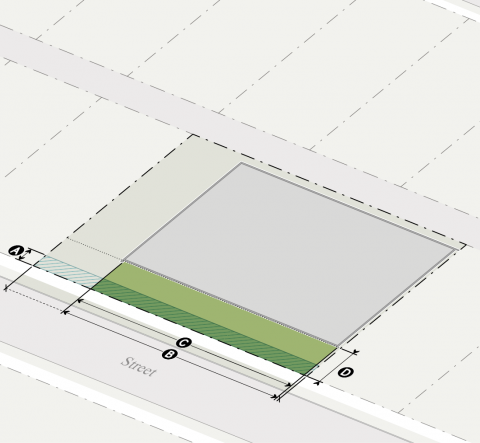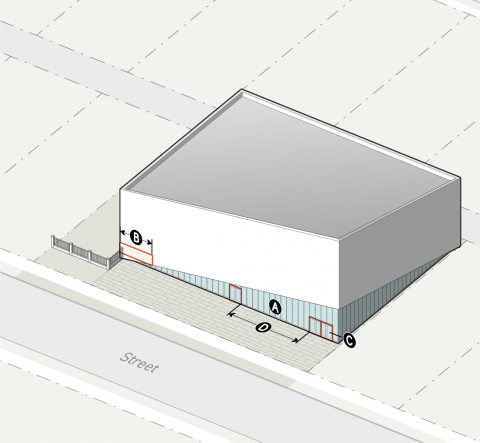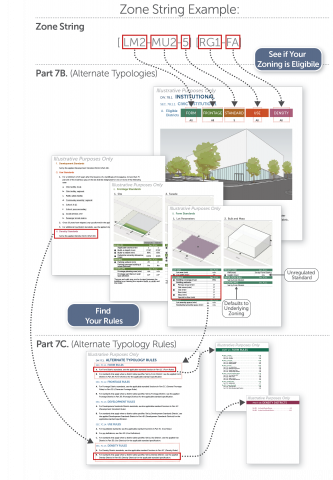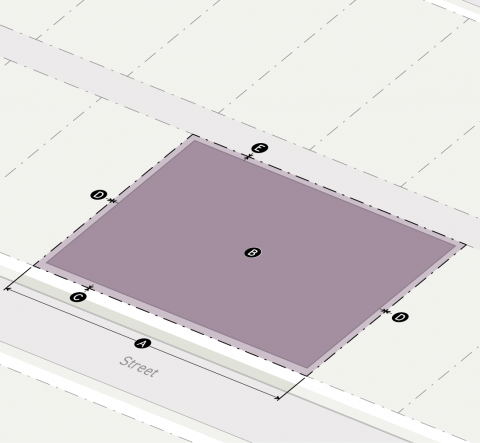Browse
Use Finder
Enter a use to see how it is organized in the Zoning Code.
Article 7. Alternate Typologies
Part 7A. Introduction
Div. 7A.1. Orientation
Sec. 7A.1.1. Relationship to Zone String
Alternative Typologies may be used on lots where all districts in the applied zone string are listed as eligible districts in the eligibility table of an Alternate Typology. An Alternate Typology either supersedes or defers to the standards of the underlying applied zoning districts as specified by the Alternate Typology.
Sec. 7A.1.2. How to Use Article 7. (Alternate Typologies)
-
Determine Eligibility
Review each component in a zone string against the eligible districts for an Alternate Typology.
-
Identify Standards
-
Form Standards
Outlined in Subsection D. (Form Standards) of each Alternate Typology (Part 7B.).
-
Frontage Standards
Outlined in Subsection E. (Frontage Standards) of each Alternate Typology (Part 7B.).
-
Development Standards
Outlined in Subsection F. (Development Standards) of each Alternate Typology (Part 7B.).
-
Use Standards
Outlined in Subsection G. (Use Standards) of each Alternate Typology (Part 7B.).
-
Density Standards
Outlined in Subsection H. (Density Standards) of each Alternate Typology (Part 7B.).
-
-
Interpret Standards
Each standard in an Alternate Typology in Part 7B. (Alternate Typologies) provides a reference to Part 7C. (Alternate Typology Rules) where each standard is explained in detail.
Sec. 7A.1.3. Alternate Typology Graphics
-
General
-
Illustrations and graphics are included in Article 7. (Alternate Typologies) only to assist users in understanding the intent and requirements of the text. In the event a conflict occurs between the text of Article 7. (Alternate Typologies) and any illustration or graphic, the text prevails.
-
To interpret the Form standard graphics in Article 7. (Alternate Typologies) see Sec. 2A.1.3. (Form District Diagrams).
-
To interpret the Frontage standard graphics in Article 7. (Alternate Typologies) see Sec. 3A.1.3. (Frontage District Diagrams).
-
Sec. 7A.1.4. Alternate Typology Naming Convention
Alternate Typology names are composed of two components: a typology category and a variation number.
-
Typology Category
The first component of each Alternate Typology name is a typology category. Typology categories group all typologies with similar allowed uses, characteristics, and intent. Typology categories are organized as follows:
-
Civic Institution
-
Corner Store
-
Small Lot Subdivision
-
Drive-Through
-
Fueling Station
-
-
Variation Number
The last component of each Alternate Typology name is a variation number. Alternate Typologies are numbered based on the order in which they were incorporated into this Zoning Code (Chapter 1A).
Div. 7A.2. General Rules
Sec. 7A.2.1. Alternate Typologies Intent
There are certain cases where the desired physical form for a specific type of development is prohibited by the zoning applied to a lot. In those cases, Alternate Typologies provide an option to override specific standards in the underlying zoning that may otherwise prohibit the desired form. In exchange for providing greater flexibility on particular standards, Alternate Typologies require adherence to other standards that promote the desired form and ensure that projects are contextually appropriate.
Sec. 7A.2.2. Alternate Typologies Applicability
-
Eligibility
Alternate Typologies are only allowed in eligible districts. Each Alternate Typology provides an eligibility table that lists all zoning districts where the Alternate Typology is allowed. Any lot within one of the eligible zoning districts may use the Alternate Typology. When an eligible district is listed with "_", all variations of the district are eligible (for example, RN_ includes RN1, RN2 and any other RN variation).
-
Project Activities
-
Alternate Typology standards apply to project activities as shown in the applicability statements of each Section in Part 2C. (Form Rules), Part 3C. (General Frontage Rules), Part 3D. (Character Frontage Rules), Part 4C. (Development Standards Rules), Part 5C. (Use Rules), and Part 6C. (Density Rules). More than one project activity may apply to a project (for example, an exterior modification may also include a use modification).
-
Project applicability may also be modified by Article 12. (Nonconformities).
-
Project activities are defined in Sec. 14.2.15. (Project Activities).
-
-
Applicable Components of Buildings & Lots
-
Alternate Typology regulations apply to all portions of a lot.
-
Alternate Typology regulations apply to all portions of buildings and structures on a lot.
-
Specific Alternate Typology regulations may further limit which components of buildings and lots are required to comply with the rules in Part 7C. (Alternate Typology Rules).
-
-
Nonconformities
-
Article 12. (Nonconformities) provides relief from the requirements of Article 7. (Alternate Typologies) for existing lots, site improvements, buildings, structures, and uses that conformed to the zoning regulations at the time they were established, but do not conform to current district standards or use permissions. No proposed project activity using an Alternate Typology may decrease the conformance with any Form, Frontage, Development, Use, or Density standard in Article 7. (Alternate Typologies), unless otherwise specified in Div. 12.2. (Form Exceptions), Div. 12.3. (Frontage Exceptions), Div. 12.4. (Development Standards Exceptions), Div. 12.5. (Use Exceptions), or Div. 12.6. (Density Exceptions).
-
Sec. 7A.2.3. Relationship to Zoning Districts
-
Where a standard is listed in an Alternate Typology, the specification listed for each standard in the Alternate Typology supersedes the specification listed in the underlying zoning districts for the same standard.
-
The underlying zoning district standard applies where an Alternate Typology:
-
Expressly defers to the underlying districts (for example, "Set by Form District");
-
Provides no specification for a standard listed by the underlying zoning districts; or
-
Does not list a standard that is listed by the underlying zoning districts.
-
Sec. 7A.2.4. Relationship to Specific Plans & Supplemental Districts
-
Alternate Typologies do not supersede the requirements of Specific Plans or Supplemental Districts.
-
Special Zones are not eligible to use Alternate Typologies.
Part 7B. Alternate Typologies
Div. 7B.1. Institutional
Sec. 7B.1.1. Civic Institution 1
-
Eligible Districts
Form
Frontage
Standard
Use
Density
All
All
5
All
All
-
Intent
The Civic Institution 1 Alternate Typology is intended to promote placemaking through architectural monuments and publicly accessible spaces. This Alternate Typology allows greater design flexibility for civic institutions to differentiate civic assets from the surrounding urban fabric, while maintaining standards essential for ensuring all projects actively contribute to a highly walkable urban environment.
-
Review
Administrative review is required, see Sec. 13B.3.1. (Administrative Review).
-
Form Standards
-
Frontage Standards
1.Site

Primary St.
Side St.
Build-to
Applicable stories (min)
1
1
A
Build-to depth (max)
0'/10'
0'/10'
B
Build-to width (min)
80%
60%
C
Pedestrian amenity allowance (max)
100%
100%
Parking
D
Parking setback (min)
25'
0'
Parking between building & street (allowed)
No
No
Landscape
Frontage planting area (min)
n/a
n/a
Frontage yard fence & wall type allowed:
A3*
A3*
*Fences and walls may not be located between the building face meeting the required build-to width and the street.
2.Facade

Primary St.
Side St.
Transparency
A
Ground story (min)
10%*
10%*
Upper stories (min)
n/a
n/a
B
Active wall spacing (max)
70’
90'
Entrances
C
Street-facing entrance
Required
n/a
D
Entrance spacing (max)
100’
150'
Entry feature
n/a
n/a
Ground Story
Ground story height (min)
Residential (min)
n/a
n/a
Non-residential (min)
16'
16'
Ground floor elevation (min/max)
n/a
n/a
*Ground story window and door glazing may be screened for up to 50 percent of the glazed area.
-
Development Standards
Set by the applied Development Standard District (Part 4B.).
-
Use Standards
-
For a minimum of 20 years after the issuance of a Certificate of Occupancy, no less than 75 percent of the total floor area on the lot shall be designated for one or more of the following uses:
-
Once 20 years have elapsed, any use allowed in the applied Use District (Part 5B.) is permitted.
-
For additional Use District standards, see the applied Use District (Part 5B.).
-
-
Density Standards
Set by the applied Density District (Part 6B.).
Div. 7B.2. Corner Store
[Reserved].
Div. 7B.3. Small Lot Subdivision
[Reserved].
Div. 7B.4. Drive-Through
[Reserved].
Div. 7B.5. Fueling Station
[Reserved].
Part 7C. Alternate Typology Rules
Div. 7C.1. Alternate Typology Rules
Sec. 7C.1.1. Form Rules
-
For Form District standards, see the applicable standard Sections in Part 2C. (Form Rules).
-
For standards that apply when a district table specifies 'Set by Form District', see the applied Form District in Part 2B. (Form Districts) for the applicable standard specification.
Sec. 7C.1.2. Frontage Rules
-
For Frontage District standards, see the applicable standard Sections in Part 3C. (General Frontage Rules) or Part 3D. (Character Frontage Rules).
-
For standards that apply when a district table specifies 'Set by Frontage District', see the applied Frontage District in Part 3B. (Frontage Districts) for the applicable standard specification.
Sec. 7C.1.3. Development Rules
-
For Development Standards District standards, see the applicable standard Sections in Part 4C. (Development Standards Rules).
-
For standards that apply when a district table specifies 'Set by Development Standards District', see the applied Development Standards District in Part 4B. (Development Standards Districts) for the applicable standard specification.
Sec. 7C.1.4. Use Rules
-
For Use District standards, see the applicable standard Sections in Part 5C. (Use Rules).
-
For use definitions, see Part 5D. (Use Definitions).
-
For standards that apply when a district table specifies 'Set by Use District', see the applied Use District in Part 5B. (Use Districts) for the applicable standard specification.
Sec. 7C.1.5. Density Rules
-
For Density District standards, see the applicable standard Sections in Part 6C. (Density Rules).
-
For standards that apply when a district table specifies 'Set by Density District', see the applied Density District in Part 6B. (Density Districts) for the applicable standard specification.





